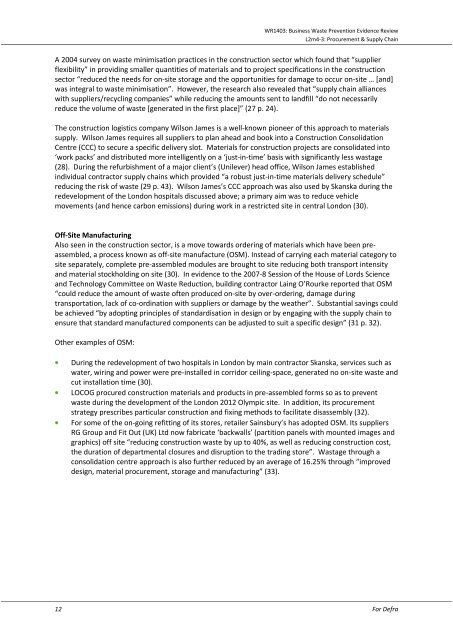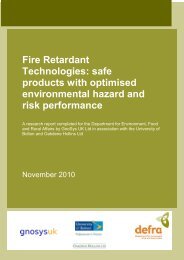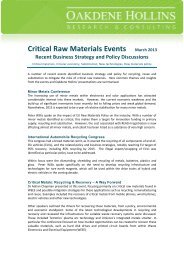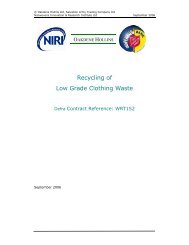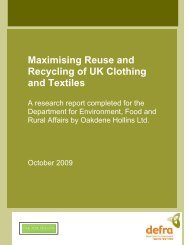Procurement and Supply Chain - Oakdene Hollins
Procurement and Supply Chain - Oakdene Hollins
Procurement and Supply Chain - Oakdene Hollins
Create successful ePaper yourself
Turn your PDF publications into a flip-book with our unique Google optimized e-Paper software.
WR1403: Business Waste Prevention Evidence Review<br />
L2m4-3: <strong>Procurement</strong> & <strong>Supply</strong> <strong>Chain</strong><br />
A 2004 survey on waste minimisation practices in the construction sector which found that “supplier<br />
flexibility” in providing smaller quantities of materials <strong>and</strong> to project specifications in the construction<br />
sector “reduced the needs for on-site storage <strong>and</strong> the opportunities for damage to occur on-site … *<strong>and</strong>+<br />
was integral to waste minimisation”. However, the research also revealed that “supply chain alliances<br />
with suppliers/recycling companies” while reducing the amounts sent to l<strong>and</strong>fill “do not necessarily<br />
reduce the volume of waste *generated in the first place+” (27 p. 24).<br />
The construction logistics company Wilson James is a well-known pioneer of this approach to materials<br />
supply. Wilson James requires all suppliers to plan ahead <strong>and</strong> book into a Construction Consolidation<br />
Centre (CCC) to secure a specific delivery slot. Materials for construction projects are consolidated into<br />
‘work packs’ <strong>and</strong> distributed more intelligently on a ‘just-in-time’ basis with significantly less wastage<br />
(28). During the refurbishment of a major client’s (Unilever) head office, Wilson James established<br />
individual contractor supply chains which provided “a robust just-in-time materials delivery schedule”<br />
reducing the risk of waste (29 p. 43). Wilson James’s CCC approach was also used by Skanska during the<br />
redevelopment of the London hospitals discussed above; a primary aim was to reduce vehicle<br />
movements (<strong>and</strong> hence carbon emissions) during work in a restricted site in central London (30).<br />
Off-Site Manufacturing<br />
Also seen in the construction sector, is a move towards ordering of materials which have been preassembled,<br />
a process known as off-site manufacture (OSM). Instead of carrying each material category to<br />
site separately, complete pre-assembled modules are brought to site reducing both transport intensity<br />
<strong>and</strong> material stockholding on site (30). In evidence to the 2007-8 Session of the House of Lords Science<br />
<strong>and</strong> Technology Committee on Waste Reduction, building contractor Laing O’Rourke reported that OSM<br />
“could reduce the amount of waste often produced on-site by over-ordering, damage during<br />
transportation, lack of co-ordination with suppliers or damage by the weather”. Substantial savings could<br />
be achieved “by adopting principles of st<strong>and</strong>ardisation in design or by engaging with the supply chain to<br />
ensure that st<strong>and</strong>ard manufactured components can be adjusted to suit a specific design” (31 p. 32).<br />
Other examples of OSM:<br />
During the redevelopment of two hospitals in London by main contractor Skanska, services such as<br />
water, wiring <strong>and</strong> power were pre-installed in corridor ceiling-space, generated no on-site waste <strong>and</strong><br />
cut installation time (30).<br />
LOCOG procured construction materials <strong>and</strong> products in pre-assembled forms so as to prevent<br />
waste during the development of the London 2012 Olympic site. In addition, its procurement<br />
strategy prescribes particular construction <strong>and</strong> fixing methods to facilitate disassembly (32).<br />
For some of the on-going refitting of its stores, retailer Sainsbury’s has adopted OSM. Its suppliers<br />
RG Group <strong>and</strong> Fit Out (UK) Ltd now fabricate ‘backwalls’ (partition panels with mounted images <strong>and</strong><br />
graphics) off site “reducing construction waste by up to 40%, as well as reducing construction cost,<br />
the duration of departmental closures <strong>and</strong> disruption to the trading store”. Wastage through a<br />
consolidation centre approach is also further reduced by an average of 16.25% through “improved<br />
design, material procurement, storage <strong>and</strong> manufacturing” (33).<br />
12 For Defra


